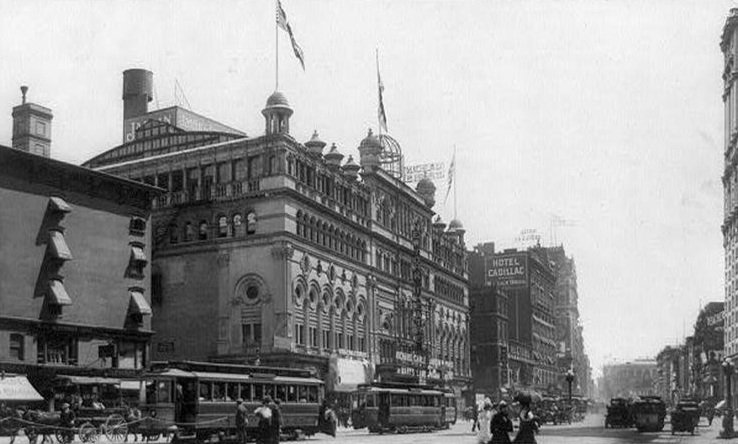The Fascinating History of Manhattan’s Street Names
Many of the city’s streets, including Bleecker, Crosby, MacDougal and Christopher Streets were named in honor of prominent early settlers. But other avenues have a more colorful origin story, going back to the Lenape and the Dutch. The name of the city itself came from the Lenape word “manahahtaan,” which translates to “the place for gathering wood to make bows.” Years later, Henry Hudson’s ship log noted the city as Manna-hata, meaning “a thicket containing wood to make bows.”
The original street grid for the city was designed in 1811. The Museum of the City of New York calls it the Greatest Grid. It set up New York for an organized expansion from the settlement on the southern tip. In 1838, using Fifth Avenue as the dividing line, cross streets were given “East” and “West” designation.
Here’s a look at the back story of some of the most famous streets in the world. This has given us an even deeper appreciation for the rich history of the place we call home.
Down on the Bowery
Photo credit: New York Public Library Junction of Broadway and The Bowery NYC 1831
The Bowery is so famous, it doesn’t need the words Street or Avenue after its name. It is the city’s oldest thoroughfare. Its first residents were ten previously enslaved families in 1645. In the late 17th century, the Dutch renamed the road “Bouwerij.” It translates to “farm,” which makes sense since it connected cattle-raising farmland in the upper parts of the city to the more urban Wall Street area. Up until 1807 it was known as Bowery Lane. This 1831 lithograph of the bucolic intersection of Broadway and Bowery shows a much different scene than today.
The Great Wide Way
Library of Congress photo of Broadway in Manhattan
Aspiring actors’ ultimate goal is to get to Broadway, first nicknamed the “Great White Way” back in 1902 due to the bright lights of the marquees, billboards, and posters. The Olympia was the first Broadway theater to use electric lights in 1895. But the theater scene is not where the internationally known, north-south thoroughfare got its name. Broadway is a translation from the Dutch phrase brede weg, or "broad road." Here’s a fun fact: Broadway follows the “Mohican Trail” created by the Lenape.
The Great Wall of Manhattan
A 1916 replica of a 1660 map of New Amsterdam, showing the Wall on Wall Street.
The Dutch originally named the heart of the Financial District (FiDi) "de Waal Straat." The most widely accepted explanation of the name is that it's derived from the 12-foot-tall wall built in 1653 by Peter Stuyvesant (check out the 1916 replica of a 1660 map of New Amsterdam), on the Dutch colony's northernmost border. Its purpose was to repel attacks from English forces, pirates, and displaced Native Americans. New Amsterdam became the English colony of New York in 1664. The wall stayed up until 1699, when it was dismantled to accommodate the expanding city. A lesser-known theory is that Wall Street may have been named for the 30 Walloon families, who were among the first European settlers of Manhattan. Alexander Hamilton lived and worked at 57 Wall Street, in a building that’s unfortunately no longer there.
Fair Maiden Lane
Broadway and Maiden Lane NYC 1885
Two blocks north of Wall Street we have the sweet-sounding Maiden Lane. There are a few theories about the origins of this street name. One is that Dutch women and girls washed clothes in the freshwater stream that flowed in this spot, then dry them on the flat stones. Other accounts say that Maiden Lane was named this because it featured a tree-lined path where young courting couples would stroll. The Dutch called it 'Maagde Paatje,’ which translates to “a footpath used by lovers along a rippling brook.” Thomas Jefferson leased a house at 57 Maiden Lane for 100 pounds a year. Most famously, this was the scene of the dinner celebrated in Hamilton’s “The Room Where It Happens” when Jefferson, Alexander Hamilton, and James Madison produced the Compromise of 1790.
Next Stop: Park Avenue
Manhattan's Park Avenue looking north from 51st Street in 1889
In the late 1880’s, most of 4th Avenue was renamed Park Avenue. There is still a 6-block stretch between Astor Place and Union Square that retains the numbered name. It was originally the route of the New York and Harlem Railroad, New York’s first passenger railroad and one of the first in the country. The tracks between 34th and 40th Streets were covered in the 1850s with grating and grass, making it park-like. By 1920, the Park Avenue Association had all of the railroad vents covered.
A Canal Ran Through It
New York City's Department of Parks and Recreation included a water feature in the small park to represent its history as the former site of Collect Pond.
A large reservoir named Collect Pond once served as a source of freshwater for downtown Manhattan residents. Tanneries began using the pond as a runoff for their waste in the late 1700s. To help drain away the polluted water, the city dug a canal in 1808 that fed into the Hudson River. When the smell of the water became unbearable, the canal was paved over, turning it into a covered sewer. Canal Street was born! The site is now known as Collect Pond Park, with a water feature to commemorate its history. As a side note, the West Village’s Minetta Lane was the site of a “brisk little brook full of trout” until it was covered in the 1820’s. Its Dutch name was Mintje Kill or “small stream.
As Walt Whitman famously noted, “Give me such shows — give me the streets of Manhattan!”
We couldn’t agree more. We care deeply for the homes of our clients, and the rich history of NYC. We are thankful for what past New Yorkers have done to make this inarguably the greatest city on earth. Here’s to you New York, New York!
Gary Mindlin is co-founder and owner of Top Hat Home Services, a full-service property care and management company. Top Hat services homes in Manhattan and are known as experts in every aspect of building management, maintenance and repair, as well as renovation and construction supervision.






